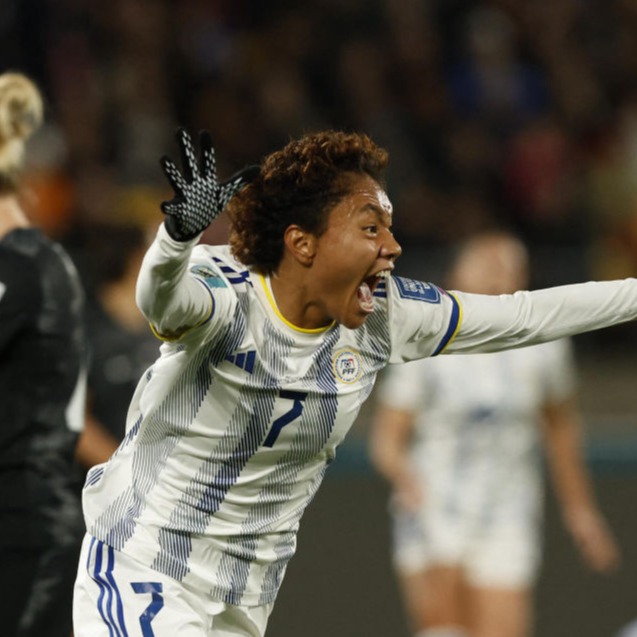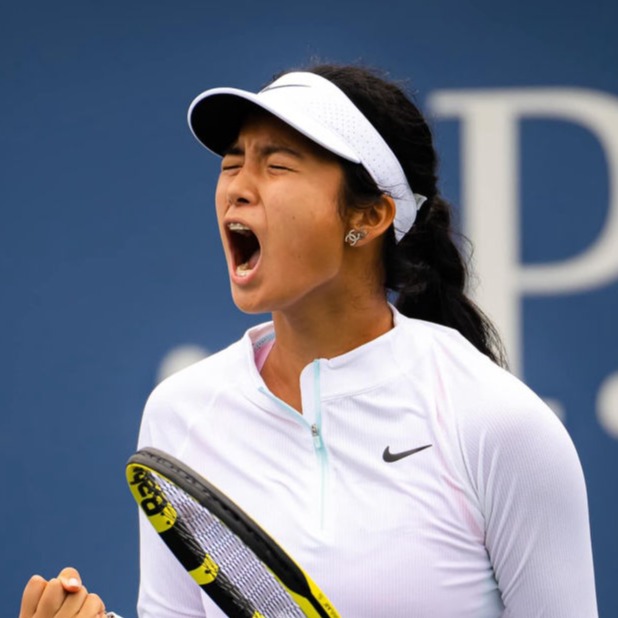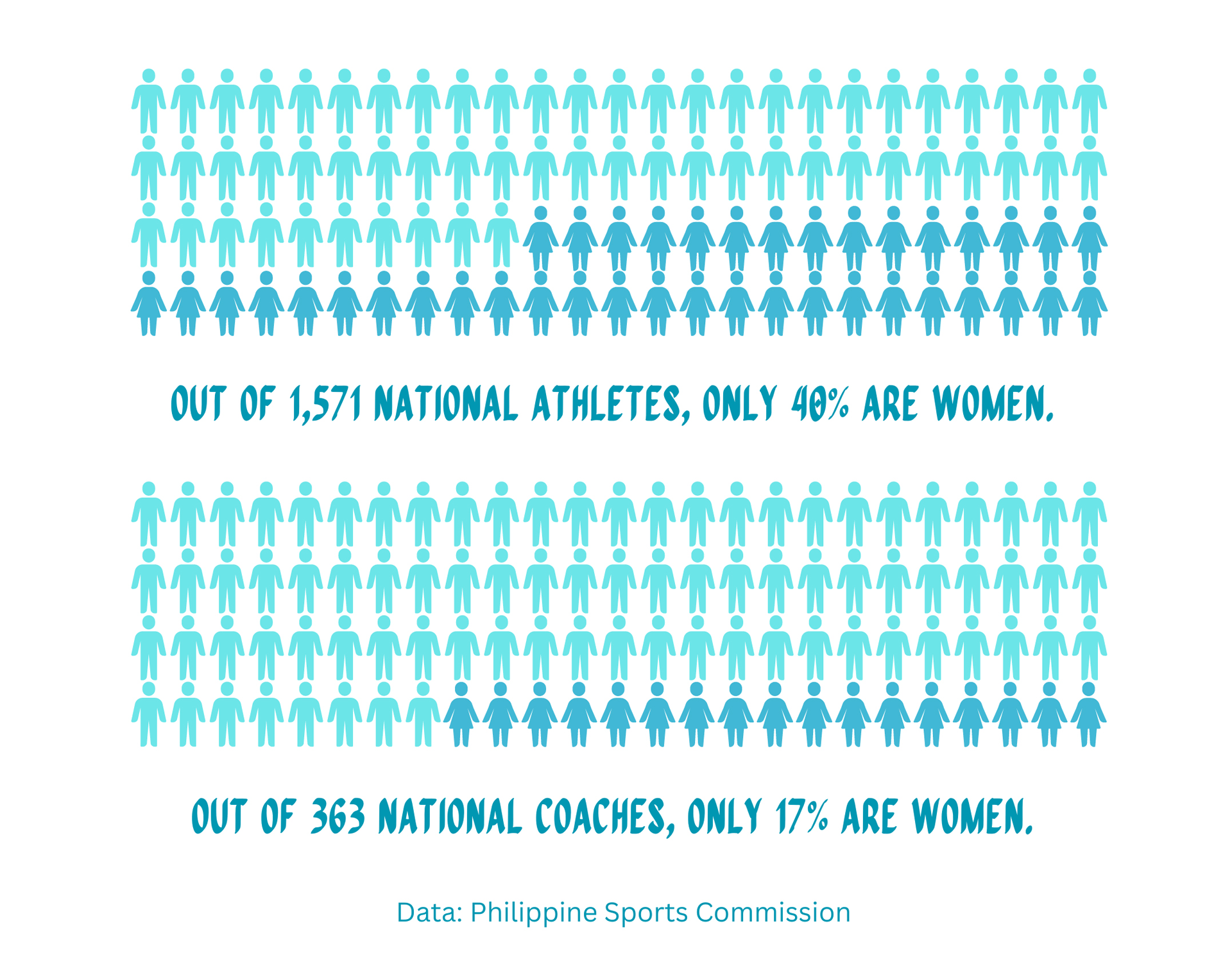We use cookies to ensure you get the best browsing experience. By continued use, you agree to our privacy policy and accept our use of such cookies. For further information, click FIND OUT MORE.
Women’s sports are on a roll in the Philippines, but there are barriers still keeping girls from participating
Words by Beatrice Go
Edited by Mikkel Bolante | Cover art by Ryan Guilas
Without a doubt, many Filipina athletes have led the way for the country in some of the biggest stages in sports.
In the Tokyo Olympics, weightlifter Hidilyn Diaz became the icon of Philippine women’s sports for winning the country’s first Olympic gold medal. The Philippine women’s football team, or more commonly known as the “Filipinas,” also made history with their maiden appearance in the 2023 FIFA Women’s World Cup – the highest level of football in the world.
In major professional leagues, Filipino teen tennis ace Alex Eala has won three Grand Slam titles and is the highest-ranking Southeast Asian player in the world at No. 189 in 2023, while Filipino-Japanese golfer Yuka Saso waved the Philippine flag proudly when she ruled the US Women’s Open in 2021.




Photos: Weightlifting's Hidilyn Diaz (REUTERS/Edgard Garrido), Football's Sarina Bolden (REUTERS/Amanda Perobelli), Tennis' Alex Eala (Alex Eala/Facebook), and Golf's Yuka Saso (Kyle Terada-USA TODAY Sports via Reuters)
But these are only a handful of female stars from a country with a population of over 50 million women (53.65 million in 2020 according to the Philippine Statistics Authority). After the historic campaigns of Diaz and the World Cup Filipinas, the public begged the question “what’s next?” or even doubted these milestones, dismissing them as "lucky".
For a nation that has ranked 16th out of 146 countries in the 2023 World Economic Forum’s (WEF) Global Gender Gap Index report (GGGR) and taken the title of most gender-equal country in Asia, the reality is a little different when it comes to sports.
In 2023, female athletes make up 40% of the national training pool of 1,571 athletes, but the Philippine Sports Commission (PSC) believes this number should be higher.
“We discovered that some national sports associations do not have a female team even though there’s a women’s event. They just don’t participate,” said PSC commissioner in Women in Sports Olivia “Bong” Coo.
To add, only 63 out of the 363 national coaches are women, constituting 17% of the pool. This despite, according to the PSC, international guidelines that require an equal number of male and female coaches in the delegation to ensure that female athletes are coached by women.

Despite having a lower percentage of female athletes and coaches in the highest level of sports in the Philippines, Filipina athletes have achieved remarkable results and wield significant influence, with some surpassing their male counterparts.
In the 2018 Asian Games, all four of the country's gold medals were secured by female athletes, and they contributed to 70% of the total medal count. Out of the 19 Filipino athletes who participated in the Tokyo Olympics, 10 of them were women, exceeding the number of men in the Philippine delegation. Diaz, of course, delivered the historic gold while boxer Nesthy Petecio also won a silver medal.
“If you notice, it’s really the female athletes giving medals to the country, so we really have to push for their training,” added Coo, who herself was a multi-awarded world champion bowler back in the 1970’s.
The author of this story conducted research among stakeholders of women’s sports – athletes, coaches, sports officials and fans – through a survey and on-site interviews in Metro Manila and sports groups in Visayas from July to August 2023. The goal was to find out what the impact of girls’ participation in sports in the Philippines has on women empowerment and the barriers in place that has hindered it.
Angel Gelisanga is a born leader.
A native of Talisay, Negros, she was active in the student government in both high school and in college. She was in charge of organizing events, and she joined talent clubs that honed her gifts for singing and dancing.
Despite having a lot of extra-curricular activities, one area she hesitated to touch was sports.
“Akala ko hindi pambabae yung sport, kaya hindi ako into sport dati (I thought that sports was not for girls, that’s why I wasn’t into sport),” said Gelisanga, who was introduced to rugby football in 2017.
Now at 27 years old, she is acting as the club development officer of Negros Island Rugby, a local club that dedicates its efforts to introducing rugby football in elementary schools in the Negros region and developing the players with the goal of producing homegrown national team members.
Gelinsanga is not alone in thinking this way.
The survey results gathered from 75 respondents revealed that even in 2023, women in Philippine sports encounter Filipino patriarchal mindsets that prevent girls from participating in sports.
“When I was younger, I was always taught that women were supposed to be prim and proper. They stay still and sit pretty. And knowing that athletes go through such hard training, I was very hesitant in joining,” said 16-year-old volleyball player Shannon Barte from Cebu.
Aside from volleyball, women’s sports in the Philippines continue to struggle in making a dent in existing structures in sports especially in varsity programs, media, and competition.
In the basketball-crazed nation of the Philippines, men’s basketball has been long-established. The Philippine Basketball Association (PBA), Asia's first professional basketball league, has been running for 48 years. And media coverage is provided from the grassroots and collegiate levels all the way up to the professional ranks.
The women’s side, on the other hand, experiences struggles that you won’t find in men’s basketball. Due to a smaller number of female athletes playing basketball, it’s already a challenge to build a squad with a full roster which results in less funding in grassroots competitions and school teams.
There have been some efforts to create a professional women’s league like the Women's Philippine Basketball League in 2008 and the Women’s National Basketball League (WNBL) in 2019, but most have folded up without reaching the levels of the men's leagues.
This issue is more prevalent in the provinces, where teams already struggle to get exposure to quality matches. Female athletes are also not able to get much access to higher levels of competition or opportunities to make sports their career.
Raya Tolentino, an alumna of the Sacred Heart School - Ateneo de Cebu, was only one of the few recruited to play in the national girls football team and landed a scholarship in Ateneo de Manila University. She also plays for the Manila Nomads in the Philippine Football Federation (PFF) Women’s League.
She was able to get the opportunity to play in Manila after being scouted at a provincial 9-a-side football tournament called Festival of Football. And while she was fortunate to make the most of her opportunity, she still believes that there are not enough competitions like this for other talent to get the needed exposure.
“Most of the time we have to come to Manila or play internationally to get scouted by schools and clubs,” shared 18-year-old Tolentino, who will start her rookie season in UAAP Season 86.
Girls' tournaments are often canceled due to inability of schools to form teams, hindering the development of other girl athletes.
The Sacred Heart School girls’ futsal team, which recently took home 2023 Palarong Pambansa title, suffered a big blow when it was unable to compete in the first season of the Cebu Schools Athletic Foundation, Inc. (CESAFI) championship after the COVID-19 pandemic.
“In order for a tournament to push through, it needs four teams – and that’s already a combination of high school and college,” explained Sacred Heart School athletics director Jon Inot.
“Only three teams were formed, so the tournament was canceled.”
Another effect of the lack of players is that girls settle with playing 7-a-side tournaments or futsal, which only requires two teams of five players in the game, while the national and international levels of competition in football are 11-a-side games.
The Palarong Pambansa, the annual national multi-sport competition organized by the Department of Education for elementary and secondary school students, only stages a futsal tournament for girls in the secondary division, while elementary and secondary boys are able to compete in a full 11-a-side football tournament.
This in itself illustrates the gap in girls’ participation in the sport on a nation-wide scale, despite the huge strides the national women’s football has been making on the international stage. The Filipinas competed in their first-ever FIFA World Cup and finished 24th out of the 32 teams, while the U-17 girls team qualified or the Asian Cup for the first time in history.
After the historic appearance of the Filipinas in the World Cup, the local players went back to their clubs that play in the PFF Women’s League, the country’s club competition for women. However, this league has yet to professionalize as the athletes only receive allowances and non-monetary benefits.
This leads most of the Filipinas' players, especially those based overseas, to continue pursuing opportunities abroad. Sara Eggesvik, Angela Beard, Katrina Guillou, Meryl Serrano and the McDaniel sisters Olivia and Chandler joined clubs in Europe, while Jessika Cowart, Jacki Sawicki and Quinley Quezada have signed with clubs competing in A-League Women, Australia’s top-division women’s football league.
Because of the underdevelopment of sports in the Philippines, a common strategy used by national sports associations is to scout for talent in the Filipino diaspora and recruit them to represent the country.
Although this is necessary to show the country’s ability to compete in the international stage, foreign-based Filipino athletes receive a lot of negative attention for not being “Filipino enough”.
Traditional sports fans and international media were quick to point out that the country’s historic FIFA Women’s World Cup roster only had one homegrown Filipino in Anicka Castañeda, a former collegiate star of the De La Salle women’s football team. A feature on the team published in an international publication was titled “The other American women’s team at World Cup”.
But with the country riding on top-level success in women’s sports, while leaving a gaping hole in its grassroots programs, why is it important to close the gap?
Sports has proven to be a vehicle of social change, including strengthening and empowering women to help build a nation.
In the survey, respondents have identified the top values they picked up from participating in girls’ sports.

The top-rated value of discipline has allowed girls to perform better and become more competitive in their own sports. But it also positively affects the lives of girls outside of sports, especially academics, as they become more productive individuals in society.
Before sports, many Filipino girls experience conforming to society’s gender roles of being at home, doing chores, and excelling in academics. But these also come with a number of issues they identified – lack of confidence, lack of fitness, unhealthy lifestyles and health issues – which are detrimental to women in society.
“Life was pretty much simple – go to school, go home and then you do homework and then do it again the following day,” shared former national volleyball player Ga Caballero, who is now coaching the girls’ volleyball team of SHS-AdC.
“Aral, bahay, TV, tulog, ganun lang ‘yung daily routine. Gumagawa din ng gawaing bahay tapos uulitin sa umaga. Sabi ko: ‘I don’t like this life (Study, go home, TV, sleep - that was the daily routine. I would do some house work then repeat it in the morning. I thought to myself: ‘I don't like this life’),’” shared SHS-AdC futsal coach Melanie Bordalba, who also shared that her current athletes struggle with being glued to their phones the whole day which contributes to a sedentary lifestyle.
But participating in sports has helped girls and women hurdle the lifestyle being dictated to them by society.
The survey respondents identified the top 5 benefits of how sports has impacted them:
In Metro Manila, private sports clinics play a big factor in introducing organized sports to young girls and boys, but these are mostly accessible to the more affluent because of the high costs for participation.
The Philippine government's support is not enough for the development of every sport, especially at the grassroots level. Even though there were projects dedicated to developing women’s sports like the Women’s Indoor and Para Games Festival and seminars on Women’s Health and Safeguarding, the PSC admits that more needs to be done.
“There are 72 sports, and that’s why we are starting by identifying sports that are giving us more women champions. But of course, I also think of the other sports that don’t receive [that investment], and maybe that’s why there aren’t many women participating in the sport,” said Coo.
Public schools, local governments, and barangays are not able to stage enough free sports clinics and competitions that are inclusive to all children. This leaves the national sports associations and even private groups to join in the responsibility of advocating for the development of sports in the nation.
In Visayas, Negros Rugby fills in the gap by initiating talks and coming into agreement with public school directors and principals to allow their students to join their practices after school, as well as offer training to physical education teachers.
The efforts have led them to hold two seasons of their tag rugby competition for children ages 11 to 13 years old. It also has helped change the game for girls’ sports as the girls teams exceed the number of boys’ teams, 8 to 5.
As the leading institution for grassroots sports in Cebu, Sacred Heart School also advocates to break barriers in sports through its Magis Eagle Sports Academy (MESA) that encourages students to join its sports clinics with the goal of inclusivity in mind.
“We mix boys and girls in different teams, so they all get to play with each other. I think that in itself is a way of training them that you’re equal and both genders have to respect each other,” said Inot.
In the pipeline, Sacred Heart School hopes to reach other schools in Cebu that need help in developing their girls’ sports programs through open plays in their facilities.
Other private groups, like Girls Got Game (GGG) and sports brands like Nike, have also made commitments to providing more opportunities for girls to get into sport and make it accessible for them.
GGG is a non-profit organization that holds sports clinics for girls in impoverished areas in the Philippines. In 2021, the organization partnered with Nike to build a basketball court in Sacred Heart Academy School in Sta Maria, Bulacan. The court was designed to encourage girls to play in the male-dominated sport of basketball.
Media plays a big role in promoting women’s sports and engaging with the audience through broadcast and coverage of their competitions.
There have been several breakthroughs in women’s sports coverage worldwide that have put into question old assumptions that there is little demand for it and public perception that women’s sports are “not as exciting as men’s sports”.
Euromonitor International has tracked how women’s sports has been growing exponentially as stadium attendance and viewership records are smashed yearly in the US and Europe.
During the 2022 FIBA Women's World Cup held in Sydney, Australia, numerous records were broken in terms of game attendance, live broadcast, and digital and social media engagement. The event achieved the highest attendance in the history of the Women's World Cup, with a total of 145,519 fans witnessing the games live at the Sydney Superdome and Sydney Sports Centre. Moreover, viewership for the USA vs. China final saw a significant increase, with ESPN US tripling its viewership compared to 2018. China set a new record with an audience reach of 750 million fans throughout the entire tournament.
The 2023 FIFA Women’s World Cup co-hosted by Australia and New Zealand also drew a record attendance of 1.9 million fans throughout the whole tournament, surpassing the previous record of 1.35 million fans in the 2015 Canada World Cup. An average of 30,911 fans were present in each game, eclipsing 2015’s average of 26,000 fans per game.
In Asia, India’s women’s cricket league called Women’s Premier League raised US$580 million just from the sale of initial franchise rights in January 2023 in its first season that ran for six weeks in March 2023. It has become the second-highest valued women’s sports league globally, just behind the Women’s National Basketball Association in the United States.
Here in the Philippines, the strongest women's professional league is the Premier Volleyball League (PVL). The league started in 2004 as the Shakey's V-League, which was an inter-collegiate league, and only professionalized in 2021. The tournament is now set to have pro league staples such as a rookie draft and salary cap, which shows that there is some momentum for the women's sport.
All of this is important, because according to the survey distributed, watching competitions and games and following inspiring athletes are the top engagement methods with girls’ sports.
Coo has six years in her mandate to increase the number of female athletes and coaches at the national level.
To do that, she and the many others like her working towards the same goal must break down some of these barriers. If they are successful, they have the chance to greatly impact the lives of many Filipino women.
“It’s fantastic when you hear how female athletes go through hardships, but being an athlete has changed their lives,” shared Coo.
“When they got into sports, it paved the way for new opportunities and dreams, which helped them overcome their setbacks and bad experiences as women.”
This story was supported by the International Center For Journalists’ News Corp Media Fellowship program.
